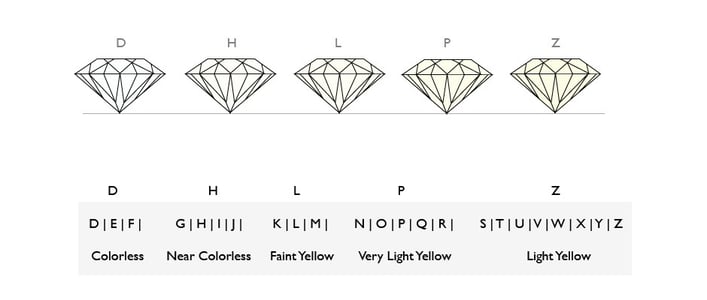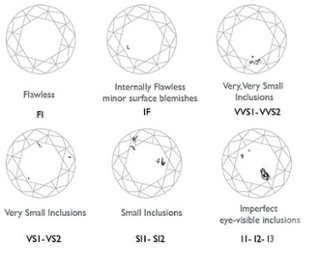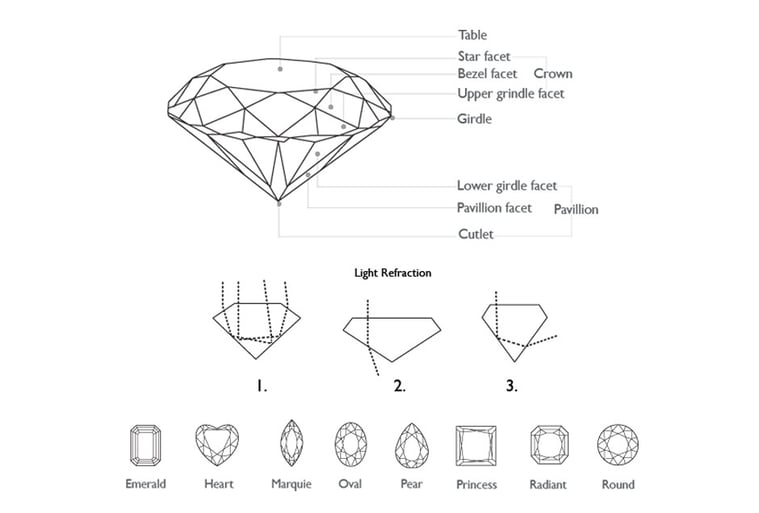I’m going to let you in on a secret, you can thank me later.
Ready to start your journey ?
.webp)
I’m going to let you in on a secret, you can thank me later.
It’s true that diamonds are forever, but contrary to popular belief, their investment potentials are skewed. I’m a diamond wholesaler and I’ll give it to you straight: many potential buyers prize certain attributes and characteristics of diamonds while severely overlooking other important traits. With the rise of the digital age and the internet, customers (perhaps like yourself) are certainly becoming better informed. However, despite the wealth of information available on the internet authoritatively discussing the 4Cs, many diamond buyers are still victims of half-truths, skepticism and often distortions.
I’ll cut to the chase and get down to what you really should know about the 4Cs. These (in)famous diamond characteristics have caused men and women the world over to both scratch their heads with confusion and fawn in obsession.
.webp)
Suresh Hathiramani, Owner & Founder, Facets Singapore Pte Ltd
The fundamental flaw of the diamond industry is that you price by weight, but you pay for brilliance
I’ll reclassify the 4Cs into two distinct groups. There are three Cs that most directly impact the price of a diamond, and there’s the one remaining C — which I, and almost every other professional diamond dealer in the trade see as the most important C of them all.

Spend 30 minutes on the internet and you will quickly find that the size of a diamond (i.e. its carat weight) is the single greatest determinant of price. There’s a good reason for this. You see, diamonds are a creation of mother nature; it takes billions to hundreds of millions of years for this shiny rock to be created. The bigger the rock, the rarer it is. And logically too, the longer it takes to form.
For instance, there is a significant price jump when you go from a 0.50ct diamond to a 1.00ct diamond, and depending on the other attributes that jump could be well over 100%. To understand this you have to consciously remember that a diamond comes naturally from Earth, and gets transformed into a beautifully cut object by man. A 1.00ct polished diamond most likely came out of the mine as a 1.90ct or 2.00ct rough. In the process of being cut into the perfect stone it loses a lot of precious weight — up to 50%. This weight loss is costly and that impacts into the price. In a nutshell everyone in the diamond industry prices diamonds by weight — but, what you want isn’t always a bigger carat. You want a diamond with optimum brilliance for the given weight
A point of interest: you seldom see a diamond from 0.95ct to 0.99ct because of the fact that a manufacturer would rather cut the rough to yield a 1.00ct or 1.01ct and sacrifice on cut/quality for a higher yield to extract a higher price per carat
When we talk about colour, we’re actually talking about the absence of it. Diamonds are graded from D-Z, don’t ask why there is no ABC (actually there is a very logical reason GIA decided not to start the colour grades with A)

I get a lot of customers that are adamant on nothing lower than an F, for example, because they saw a chart similar to the one above and don’t like the idea of a ‘near colourless’ stone. Frankly speaking, anything higher than an ‘H’ is just fine. If I showed you an ‘H’ and said it was a D you probably wouldn’t know the difference until seeing it side by side with an actual D. Colour does affect price though, so going for a lower colour has great benefits if you want a larger stone. Do take note, the bigger the stone and the ‘lower’ the colour grade the more noticeable the colour can be. However, at the 1.00 carat range which is typical for engagement rings, F to H is your best bet in terms of value for money. Every step in colour can influence price anywhere from 10–20%. Hence, it really depends on where you want to compromise and what you care about more.

As I mentioned earlier, natural diamonds are a creation of mother nature, the result of pure carbon exposed to tremendous heat and pressure in the Earth’s mantle over eons. At some point during the hundreds of millions of years-long process, diamonds develop inclusions and tiny fissures within them, as well as ‘blemishes’ on the surface. Think of them as the imperfections we all have: moles, scars, freckles etc.
I won’t get into too much detail on what the clarity terms mean as there is enough information out there if you’re really interested
ˈklarɪti/ noun
1. the quality of being clear, in particular:
the quality of being easy to see or hear; sharpness of image or sound
The key here is understanding how grading labs such as the Gemological Institute of America (GIA) determine the clarity of a diamond. By definition, the clarity of a diamond is about the inclusions that you can see under 10x magnification, through a jeweller’s loupe. However, a little-known fact to the general public is that most grading labs use a 60x magnification microscope during the grading process. While focused on a single flaw, they can switch to the loupe magnification of 10x. If they can still see these flaws at 10x magnification then they have to give a relevant grade based on how visible or not those flaws are and their relative positions. With the naked eye you aren’t going to see any difference between a flawless diamond all the way until at least an SI1. In fact, no diamond is truly flawless, it is only given that grade because at 10x you absolutely cannot see the flaw(s) even though they may exist. That being said, you will notice a significant difference in price between the various clarities, (especially true in the higher clarities - VVS1, VVS2, VS1 etc).
Another fundamental misunderstanding with regard to clarity is the plot diagram. Included in GIA reports for diamonds above 1.00 carat, and almost all other reputable grading labs, these plot diagrams help an individual identify the location of a flaw.
The problem here is that it doesn’t truly reflect the size or other characteristics of that flaw. Is the inclusion obvious, is it white, black, grey? A good example is the cloud. A cloud is a cluster of tiny pinpoints. It can be a group of 10 to 20 pinpoints or more, but the plot diagram symbol will not reflect that because it’s a universal symbol for any type of cloud, with any number of pinpoints. When reviewing the certificate, two seemingly identical VS1 stones can be opposite in attraction because one has a single tiny cloud symbol on the plot diagram whilst the other has many isolated ones, but both are given a grade of VS1. When it comes down to it, would you rather have a diamond with a tiny white cloud or just a few black pinpoints? There is no right answer, but generally speaking within the trade any white inclusion, whether a crystal, cloud, or other, is preferable over a black inclusion and thus commands a higher price.
A lot of emphasis is usually placed on the size, colour and clarity of a stone. In fact, diamonds are always priced by these three Cs. You don't often see Cut mentioned in the description when diamonds are offered for sale, or mentioned in most diamond price listings. Cut is usually mentioned in passing or as an afterthought.

That’s a real shame because Cut; is the most important factor influencing the brilliance of a diamond, which is what you’re really paying for.
Brilliance has everything to do with the nature and physics of light. Reflection and refraction (remember your high school glass prism experiment) are key to a diamond’s brilliance; it’s all about light passing through and how reflective the diamond is based on the ‘optimum’ measurements. However, this is where it gets confusing.
Many retailers and a myriad of third party companies tend to brand their diamonds using terms such as ‘Best’, ‘Ideal’, ‘Super Ideal,’ etc. I don’t like wasting time with these because at the end of the day every professional in the trade should base their assessment of Cut on the grading gold standard in the industry - the GIA who initially came up with the 4Cs.
A GIA report mentions a Cut grade (only) for round brilliants and is made up of five grades: excellent, very good, good, fair, and poor. The parameters they use for these grades are both theoretical and slightly subjective too, thus confusing things even further.
To make things simple, avoid anything worse than ‘Very Good’. You simply won’t get the brilliance you want. No doubt there is good science behind how they derive the Cut grade, but the spectrum is broader than commonly understood. Just because two similar diamonds both have an ‘Excellent’ cut grade will not mean they have the same brilliance or are the same. I know, I’m confusing you even further am I not? Don’t fret, it will make more sense soon.

Suresh Hathiramani, inspecting a diamond using a traditional 10x loupe. Notice how close the diamond and loupe is held to the eye.
Evaluating a diamond purchase isn’t just about the stats, the gimmicky scores or countless derivations of the 4Cs that exist today. Like any other specialist, diamond traders are experts in their field for a reason. That’s why consumers who spend hours researching diamonds can come out even more confused, ultimately having to rely on our expert opinions.
At Facets, every stone we purchase is carefully hand selected and carefully scrutinised before a decision to buy is made. There are standards and then there are standards. We live by higher standards. Other retailers and dealers may choose lower standards in order to gain market share, but it doesn’t address the issues faced by a clueless customer. Instead, all that a lowered standard leaves them is with a false sense of having obtained a bargain. More often than not they come in well read and empowered, demanding to know why two very 'similar' diamonds can be so different in price, a factor that is taken quite seriously in today's competitive business environment.
I like to tell a story to my clients when they examine two seemingly identical diamonds and wonder why there is such a price difference between the two. Imagine, if you will, a hypothetical situation: two human specimens, let us call them Bob & Joe. Both Bob and Joe have achieved the exact same grades in school, straight ‘A’s.
Courtesy: GIA Gem Labs
Both Bob & Joe have the exact same biometric data: age 22, height 5' 10" and weight 160lbs. Both Bob & Joe run a mile in 7 minutes flat, play the piano and are on the school’s football team.
On paper, you would think Bob & Joe are equally outstanding, but when you meet Bob in person you realize he is an extrovert, extremely funny and outgoing, while Joe is an introvert, extremely shy and soft spoken. Despite the fact that they appear the same on paper, statistics would side with Bob getting a summer internship over Joe, for our society values extroverts just a little more than introverts. Poor ol’ Joe.
Well, it’s something similar with diamonds. I can show you two diamonds of 2.20 carat each, D VS1 grades with the same cut, polish and symmetry grades. Upon viewing the stones, it is often apparent that one of them ‘speaks louder' to you, that it just vies for your attention that little bit more, and this in fact and in my actual experience is based solely on the notion of brilliance I was talking about earlier.
As a counter, many would argue that there are reflectometers and ratings out there that can objectively measure a diamond’s brilliance based on ideal parameters and values, so it is wiser to pay for a ‘better’ diamond based on those scores. With that argument, I shall not doggedly contest - it’s partially true! Those readings can accurately determine the brilliance of a diamond measured by it’s light reflectivity. However, one has to realize that brilliance ratings such as the HCA score base their findings on scientific methods and, like all scientific methods, require controls on consistency. One doesn’t wear a diamond under controlled lab conditions all the time unless they’re a doctor, researcher or actually live in a lab, I guess.
Ultimately, buying a diamond technically means understanding the 4Cs objectively but, more importantly, accepting that they are derived quite subjectively. Ah, the paradoxes are real in this industry!
Whether you choose to buy online, at a big retail chain or from your trusted local jeweller, it is fundamental to not be swayed by too much ‘analysis paralysis.’ The 4Cs and the grade of a diamond help determine the indicative price, and that is how us diamond people use them too. But, what matters most is buying the diamond that’s right for you, that speaks to you. Budget is always a concern, so finding a diamond that you love for the right price is perhaps the closest you may get to feeling well and truly satisfied.
Just please, don’t buy a synthetic or lab grown diamond.
If you need help to choose the right diamond for your next purchase, come...

Digital Creator | Founder of @pprxteam | @northeastern & @startupInst Alumni | www.nikhathi.com.
Graduate from North Eastern University in Boston, this esports team owner is also an expert on certified diamonds. Trained at GIA, New York, Nikhil carries with him 5-years of experience in the diamond business and has a fresh, unconventional writing style that resonates with today's Gen Y and Z.
Unique industry insights into the world of diamonds, ring selection & design tips, plus the latest in jewellery trends & much more...
